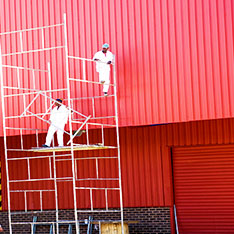How to make your Paint last longer?
1. Fix indoor moisture problems
Start by repairing roof leaks and soggy basements and make sure the vents of kitchen and bath are to the outside. Moisture can enter a home as a liquid, but it leaves in a vapour form that lifts exterior paint along with it when it exits the wall outside poorly vented rooms.
2. Repair damaged surfaces
If your wood is affected by rot or insects or gouged by careless ladder placement, do not paint over it. Replace the damaged wood or repair it before painting. Throw out any rusty fasteners. Rusted blister transfers the oxides to the paint, staining it if water runs over.
3. Clean siding and trim
Paint won’t stick to a dirty surface, therefore, you have got to remove dirt, mildew, cobwebs and greasy gunk first. Proceed the cleaning in two stages.
First, apply a mildew-killing solution using a garden spray, bleach and water. Next, using siding cleaner which is sold at paint stores and home centres, remove weathered paint and greasy dirt. You can then go for either power wash or hand scrubbing using a garden hose and nozzle. Rinse thoroughly and gently to remove cleaner residue so this residue does not loosen paint applied over it.
4. Scrape and sand
Remove the old damaged paint using a sandpaper to feather the rough edges left behind. If you re-apply over the previously damaged paint, the sharp edges will create thin, weak areas in the new paint. Brush away any dust created during scraping and rinse the siding and trim gently.
5. Prime if necessary
Primer is to the topcoat what the foundation is to your makeup. Areas scraped to bare wood and spots that have hairline cracks but are otherwise sound need a layer of primer. If the house needed extensive scraping then prime the entire house.
6. Apply paint correctly
Apply the paint at the right thickness of about 4 to 5 mils (0.004 to 0.005 in.) when wet. The thickness of the paint should be as thick as a sheet of copier paper. The dried paint will be weak if the layer is too thin. The paint will sag and crack if the layer is too thick.
There is a device called a wet-film thickness gauge by which you can measure the paint’s wet thickness. Only pros use these gauges, to be honest, and often it is used just to check that their helpers are not spreading the paint too thin or thick.
If you are still confused about getting the perfect paint job done and are looking for a professional help then contact Pro Painters Sydney now at 0403 360 662.




